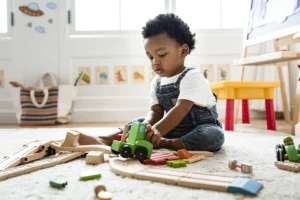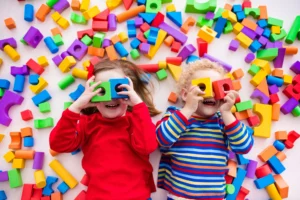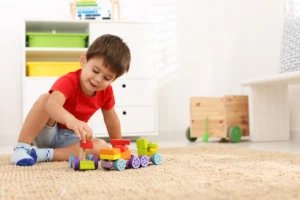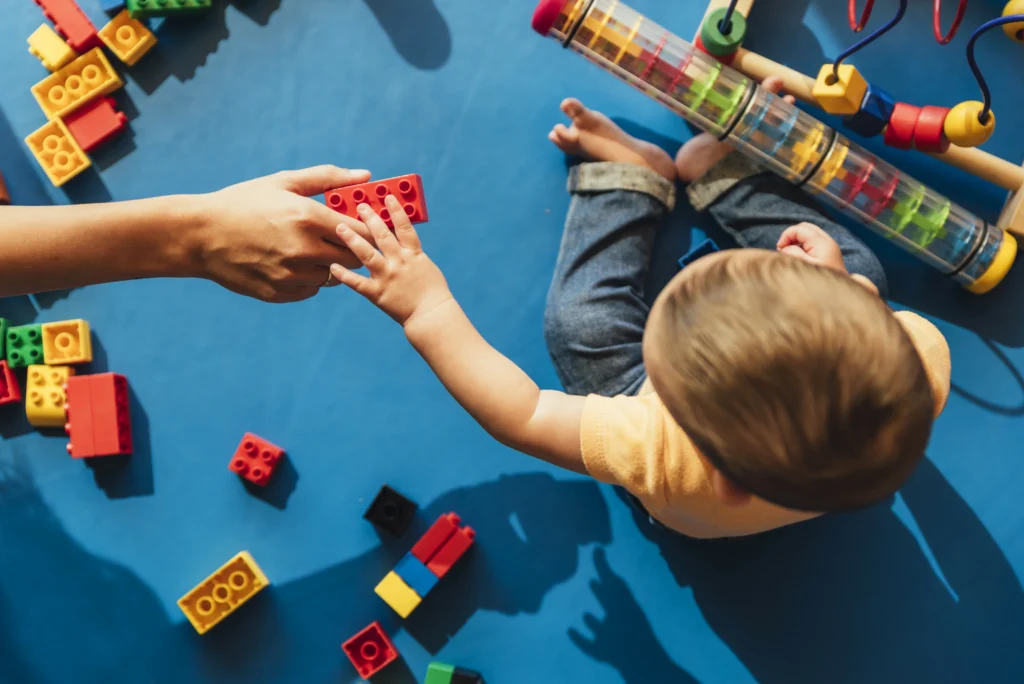The Role of Play in a Child’s Cognitive and social-emotional Development
the role of play is essential for a child’s cognitive and social-emotional development. Here’s a more in-depth look:
Cognitive Development and Play:
- Infants and Toddlers: Simple exploratory and sensory play helps develop memory, problem-solving, and language skills.
- Preschoolers: Pretend/imaginative play allows them to practice planning, sequencing, and flexible thinking.
- School-age: Constructive play with blocks, puzzles, and games fosters spatial skills, math concepts, and critical thinking.
- Throughout childhood: Open-ended play encourages creativity, experimentation, and divergent thinking.
Social-Emotional Development and Play:
- Infants and Toddlers: Social play like peek-a-boo helps build attachment, trust, and joint attention.
- Preschoolers: Cooperative play teaches sharing, turn-taking, conflict resolution, and empathy.
- School-age: Group games and sports develop leadership, teamwork, emotional regulation, and sportsmanship.
- All ages: Play allows children to safely process emotions, build confidence, and develop a sense of self.
Some key ways play supports social-emotional growth:
- Allows children to practice social skills in a low-stakes environment
- Provides an outlet for expressing and working through feelings
- Builds self-esteem through mastery of skills and games
- Facilitates bonding with peers and family members
- Teaches self-regulation through following rules and taking turns
Overall, play is not just fun, but is essential for healthy cognitive, physical, social, and emotional development throughout childhood. Providing ample opportunities for different types of play is crucial.

How can parents and educators best incorporate play-based learning into a child’s daily routine?
Incorporating play-based learning into a child’s daily routine is so important, and there are several strategies parents and educators can use:
For Parents:
- Set aside dedicated “play time” each day, whether it’s 30 minutes or a couple of hours. This sends the message that play is valued.
- Rotate different types of toys and materials to encourage exploration and new types of play.
- Participate in play activities with your child – get on the floor, ask questions, and extend the play. This supports bonding and learning.
- Take play outdoors whenever possible, as outdoor play supports physical, cognitive, and social development.
- Narrate your child’s play to build language skills, e.g. “You’re stacking the blocks so high!”
- Avoid over-scheduling structured activities – leave room for open-ended, child-directed play.
For Educators:
- Design the classroom environment to facilitate different play areas (blocks, dramatic play, art, etc).
- Incorporate play-based learning into the curriculum, integrating it with academic concepts.
- Model and guide play interactions, asking questions to deepen learning.
- Observe children’s play to assess development and guide future activities.
- Collaborate with families to understand each child’s play preferences and routines.
- Advocate for policies that protect ample time for play in the school day.
The key is striking a balance – providing structure and guidance while allowing children the freedom to explore and direct their own play. This empowers them to be active participants in their learning.

How can parents incorporate play-based learning during family outings or weekend activities?
There are lots of opportunities for parents to incorporate play-based learning during family outings and weekend activities. Here are some ideas:
At the Park:
- Have an impromptu treasure hunt, looking for different shapes, colors, and textures in nature
- Set up an obstacle course using the playground equipment
- Encourage imaginative play by bringing props like capes, wands, or a picnic basket
- Play classic games like tag, hide-and-seek, or I Spy
On a Hike or Nature Walk:
- Have kids collect leaves, rocks, or other natural items to categorize or use for art projects
- Challenge them to mimic animal movements or sounds
- Look for signs of the changing seasons and discuss how nature adapts
- Engage the senses by having kids close their eyes and describe what they hear/smell
At the Museum or Zoo:
- Turn exhibits into scavenger hunts, looking for specific animals, artifacts, or information
- Role-play what it would be like to be a curator or zookeeper
- Encourage sketching, note-taking, or writing stories about the experience
- Discuss what was most interesting or surprising about the visit
At the Grocery Store:
- Have kids help plan the shopping list and locate items in the store
- Count, sort, or compare different fruits and vegetables
- Create a rhyming game with items on the shelves
- Talk about where different foods come from
The key is turning everyday outings into engaging, hands-on learning opportunities through play. This makes the activities more memorable and builds valuable skills. Let me know if you need any other suggestions!

What are some effective strategies for encouraging more open-ended, imaginative play among children of different ages?
encouraging open-ended, imaginative play is so important for a child’s development. Here are some effective strategies parents and educators can use with children of different ages:
For Infants and Toddlers (0-3 years):
- Provide simple, open-ended toys like blocks, play dough, or musical instruments
- Create play spaces with minimal clutter and distractions
- Model imaginative play yourself, using toys in creative ways
- Narrate their play to build language skills, e.g. “You’re making the doll dance!”
- Avoid over-structuring their playtime – allow them to explore freely
For Preschoolers (3-5 years):
- Set up dedicated “pretend play” areas with dress-up clothes, play kitchens, etc.
- Rotate different themed props and materials to spark new ideas
- Encourage them to plan out their play scenarios and act them out
- Ask open-ended questions to expand their storylines, like “What happens next?”
- Participate in their play, but let them take the lead
For School-Age Children (6-12 years):
- Provide building materials like Legos, craft supplies, or recycled items
- Suggest broad prompts to inspire imaginative projects, like “Create your dream treehouse”
- Let them play collaboratively, working together to build or enact stories
- Avoid excessive screen time, which can limit their creative thinking
- Praise their creativity and original ideas to build confidence
Across all ages, the key is minimizing overly-directive toys/activities, allowing freedom to explore, and empowering children to take the lead in their play. This nurtures imagination, problem-solving, and a love of learning.
Can you provide examples of open-ended play activities that work well for mixed-age groups of children?
here are some great examples of open-ended play activities that work well for mixed-age groups of children:
Art and Sensory Exploration:
- Set up a large drawing/painting station with various art mediums (crayons, markers, paints, etc.)
- Provide modeling clay, play dough, or other tactile materials for sculpting and shaping
- Fill a sensory table with items like sand, water, rice, or dried beans for scooping and pouring
These types of open-ended art and sensory activities allow children of all ages to explore and create at their own level. Older kids can experiment with blending colors or sculpting more complex forms, while younger ones focus on the sensory experience.
Dramatic Play:
- Create a pretend play area with costumes, props, and open-ended role-playing materials
- Include items like play kitchen sets, dolls, play tools, or dress-up clothes
- Encourage kids to work together to act out stories, settings, and scenarios
Dramatic play sparks the imagination and allows children to practice social skills. Older kids can take on more complex roles and plotlines, while younger ones join in the play.
Construction and Engineering:
- Provide building materials like blocks, Legos, cardboard, and other recyclables
- Challenge kids to work together to build structures, vehicles, or inventions
- Ask open-ended questions to prompt their problem-solving and creativity
Building and engineering play develops spatial awareness, fine motor skills, and collaboration. Younger children may focus more on exploration, while older ones can take the lead in designing more intricate creations.
Outdoor Exploration:
- Set up a nature scavenger hunt or obstacle course in the backyard or park
- Encourage kids to collect natural items (leaves, rocks, etc.) and use them creatively
- Organize active group games like hide-and-seek, tag, or relay races
Outdoor play promotes physical activity, imagination, and social interaction across age groups.
The key is providing a variety of open-ended, engaging materials that allow children to play and learn at their own pace and developmental level.

